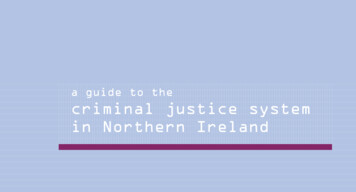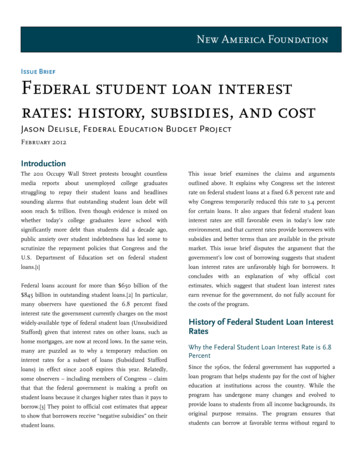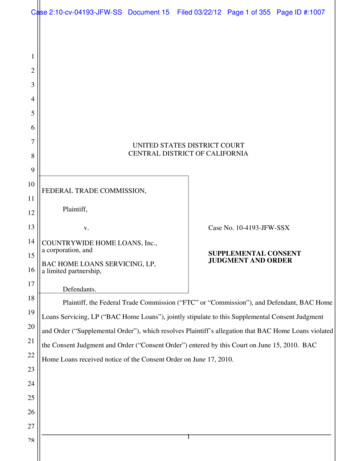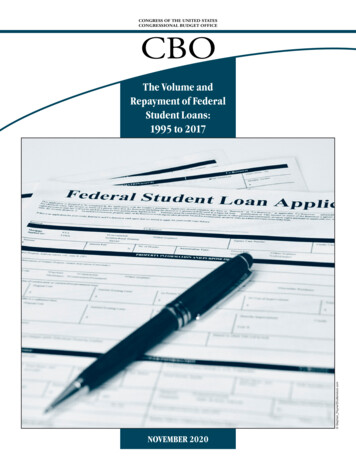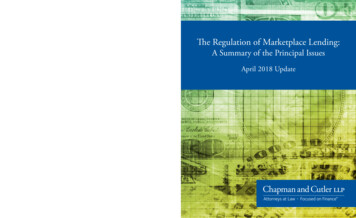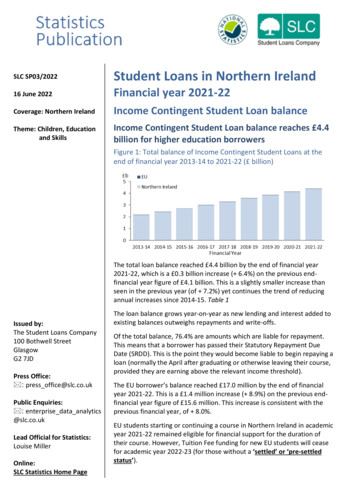
Transcription
SLC SP03/2022Student Loans in Northern Ireland16 June 2022Financial year 2021-22Coverage: Northern IrelandIncome Contingent Student Loan balanceTheme: Children, Educationand SkillsIncome Contingent Student Loan balance reaches 4.4billion for higher education borrowersFigure 1: Total balance of Income Contingent Student Loans at theend of financial year 2013-14 to 2021-22 ( billion)The total loan balance reached 4.4 billion by the end of financial year2021-22, which is a 0.3 billion increase ( 6.4%) on the previous endfinancial year figure of 4.1 billion. This is a slightly smaller increase thanseen in the previous year (of 7.2%) yet continues the trend of reducingannual increases since 2014-15. Table 1Issued by:The Student Loans Company100 Bothwell StreetGlasgowG2 7JDPress Office: : press office@slc.co.ukPublic Enquiries: : enterprise data analytics@slc.co.ukLead Official for Statistics:Louise MillerOnline:SLC Statistics Home PageThe loan balance grows year-on-year as new lending and interest added toexisting balances outweighs repayments and write-offs.Of the total balance, 76.4% are amounts which are liable for repayment.This means that a borrower has passed their Statutory Repayment DueDate (SRDD). This is the point they would become liable to begin repaying aloan (normally the April after graduating or otherwise leaving their course,provided they are earning above the relevant income threshold).The EU borrower’s balance reached 17.0 million by the end of financialyear 2021-22. This is a 1.4 million increase ( 8.9%) on the previous endfinancial year figure of 15.6 million. This increase is consistent with theprevious financial year, of 8.0%.EU students starting or continuing a course in Northern Ireland in academicyear 2021-22 remained eligible for financial support for the duration oftheir course. However, Tuition Fee funding for new EU students will ceasefor academic year 2022-23 (for those without a ‘settled’ or ‘pre-settledstatus’).
Table of Contents (click for hyperlink)Income Contingent Student Loan balance1Introduction3What can you use these statistics for?3Things you need to know3Total amount paid out in loans to student borrowers5Interest added to Income Contingent Loans7Average Income Contingent Loan balances8Income Contingent Loan borrower repayment status9Income Contingent Loan repayments11Income Contingent Loan repayments by repayment method12Average amount repaid by repayment method14Additional information15Page 2 of 17
IntroductionThis statistics publication presents figures and observations on student loan outlays, repayments andborrower activity for Northern Ireland domiciled Student Loans Company (SLC) customers. This coversstudents who are studying, or borrowers who have studied in higher education (HE) and further education(FE) in the United Kingdom (UK). Figures are also shown for European Union (EU) students studying inNorthern Ireland.Figures provided here are for Income Contingent Repayment (ICR) Loans administered by SLC, which wereintroduced in academic year 1998/99.This publication covers financial years up to and including 2021-22.Complete information on student finance arrangements in Northern Ireland are available at the StudentFinance Northern Ireland website.What can you use these statistics for?These statistics can be used as a reference to the value of the Student Loans Company (SLC) loan balanceat the end of the financial year, student outlay within a financial year and information on borrower activityand repayment amounts.The data used in this publication is sourced from Student Loans Company’s ‘Customer Ledger AccountServicing System’ (CLASS). This system only holds information on borrowers who have received fundingfrom SLC. This publication also only includes information on loan products and does not includeinformation regarding grants and bursaries. Under normal circumstances grants and bursaries are notconsidered repayable.Due to this, these statistics cannot be used to analyse trends or to draw conclusions regarding the full UKeducation funding landscape.Things you need to knowMore Frequent Data Sharing (MFDS)From April 2019 the frequency in which repayments data is provided to SLC by HM Revenues and Customs(HMRC) increased. Before this SLC received customer repayment data, reported by employers, annuallyfrom HMRC after the end of the financial year. This increased to weekly. This meant for SLC customersbeing paid monthly through the Pay as You Earn (PAYE) system, SLC receives information of student loandeductions monthly. This increase in frequency resulted in a change in time series for repayments andinterest applied for the 2019-20 financial year. From the 2020-21 financial year, the time seriesnormalised with a single years’ worth of repayments data being included (just those processed by SLCwithin that financial year).For more information on how this affected repayments and resulting interest calculations, please refer toour Additional information section and for additional detail, please refer to GOV.UK.Page 3 of 17
Self-Assessment dataSelf-Assessment repayment data is supplied from HMRC to SLC via a different process to PAYE. As a result,this will still be provided annually after the end of the financial year (and not weekly as for PAYEcustomers). This will therefore still show in the financial year in which it was posted to the customer’saccount, as in previous years. For this reason, financial year 2021-22 will mostly comprise of SelfAssessment repayments data from the previous financial year. This will also be true of the interestcalculations being applied for these borrowers.In Table 1, in previous years we have had to mark the figures relating to Self Assessment repayments as‘estimated’ due to this being provided later than anticipated. From 2018-19 this has been provided asexpected, allowing this to be included as final figures.In Table 4A we therefore mark the latest financial year of repayment as ‘provisional’ as the 2021-22 SelfAssessment earnings information is received from HMRC after the 30 April effective date. The final figure isshown in the following years’ publication.Effective datesThe effective dates used in this publication are as follows:Table 1 and 2:Table 3, 4 and 5:31 March30 AprilTables 3, 4 and 5 provide information which requires annual PAYE end of year data supplied by HMRC toSLC, even after the introduction of MFDS. This is received after the financial year ends hence the latereffective date.Page 4 of 17
Total amount paid out in loans to student borrowersLoans discussed in this section include Tuition Fee Loans and Maintenance Loans for undergraduates andTuition Fee Loans for postgraduates.Total amount paid out in loans to higher education borrowers remainsrelatively constant at 359.5 million in financial year 2021-22Figure 2: Total amount paid out in loans to higher education undergraduate borrowers in financialyears 2013-14 to 2021-22 ( million)The amount paid out in higher education loans (undergraduate and postgraduate) in financial year 2021-22was 359.5 million. This was a 2.6 million increase ( 0.7%) in comparison to the previous year. This %increase was lower than the 1.9% noted in the previous year ( 6.6 million). Table 1In regard to undergraduate Tuition Fee Loans, a total of 221.7 million was paid out on behalf of NorthernIreland and EU borrowers in financial year 2021-22, an additional 2.5 million ( 1.1%) compared to 202021. This is a lesser increase than noted in the previous financial year, when a further 5.1 million ( 2.4%)was paid out in comparison to 2019-20.Figure 3: Total amount of Tuition Fee Loans paid out on behalf of EU undergraduate borrowers infinancial years 2013-14 to 2021-22 ( million)Page 5 of 17
Of the total amount paid out in Tuition Fee Loans, 1.8 million was paid on behalf of EU borrowers; asignificant 20.3% increase ( 0.3 million) on the previous year. This is a considerably higher % increasethan noted in previous years ( 2.7% in 2019-20 and 11.5% in 2020-21).The financial year 2021-22 increase can be attributed to a late influx of EU applications in the final monthsof 2020. The later submission of these applications could be as a result of the 31 December 2020 deadlineto apply for the EU Settlement Scheme for UK residency, along with travel limitations and laterrecruitment by higher education providers as a result of the COVID19 pandemic.For further detail on Tuition Fee Loans, and other student support paid in academic year 2020/21, pleaserefer to our Student Support publication released in November 2021.A total of 126.1 million was paid out to higher education undergraduate borrowers in the form ofMaintenance Loans in financial year 2021-22. This is relatively consistent with the amount paid out in theprevious year (- 0.4 million / - 0.3%). Also, when comparing 2019-20 to 2020-21, a similar level ofreduction is evident (- 0.9%).Figure 4: Total amount of Tuition Fee Loans paid out on behalf of postgraduate borrowers infinancial years 2013-14 to 2021-22 ( million)In financial year 2021-22, 11.8 million was paid out on behalf of postgraduates in the form of Tuition FeeLoans, 0.4 million more ( 3.7%) than in the previous year.Following a typical significant increase in the product’s second year ( 143.6%) from 3.7 million to 9.1million in 2018-19, the amount paid out has since increased year-on-year (except for a small decrease in2019-20 of 3.7% / 0.3 million).Page 6 of 17
Interest added to Income Contingent LoansThe interest charge is affected by a cap at the bank base rate of 1%. The interest rate is the lower of theRPI at the preceding March, or 1% above the highest base rate of a nominated group of banks calculatedregularly during the year. The interest rate does not affect the monthly repayment amount of IncomeContingent Loans; it will affect the time taken to repay. 48.0 million interest accrued on higher education loans in financial year2021-22Figure 5: Total amount of interest accrued on higher education loans in financial years 2013-14 to2021-22 ( million) 48.0 million in interest was accrued to loan accounts in financial year 2021-22, 2.5 million higher( 5.6%) than in 2020-21. Table 1As a % of the closing balance, this remains constant at 1.2% in both financial year 2020-21 and 2019-20.The greater increase between 2018-19 and 2019-20 was predominantly due to ‘More Frequent DataShare’- the more readily available data provided to SLC by HMRC. This meant that effectively, almost twoyears’ worth of customer PAYE repayments and resulting interest calculations (those processed by SLC inboth FY 2018-19 and 2019-20) were included in the 2019-20 financial year. The time series normalised infinancial year 2020-21, and since then only includes one financial year of interest calculations (just thoseprocessed by SLC in that financial year). Further detail can be found in the Additional information section.For more information on interest rates and calculations, please refer to our Income Contingent StudentLoan repayment plans & interest rates and calculations page.Page 7 of 17
Average Income Contingent Loan balancesThis section looks at the average loan balance for borrowers at the point where their liability to repay firstbegan (usually the April following the completion, or withdrawal from their course, provided they areearning above the relevant income threshold). The average loan balance reflects the amount paid toborrowers, plus interest added whilst they were studying, minus any voluntary repayments made byborrowers prior to them becoming liable to repay.Average higher education borrower’s loan balance on entry into repaymentremains relatively constant at 24,360Figure 6: Average loan balance on entry into repayment by repayment cohort as at the beginningof the financial year 2022-23: Northern Ireland & EU ( )The average loan balance for the 2022 repayment cohort on entry to repayment remained relatively aswas reported in the previous year (- 0.6% / - 150). Although very small, this is the first year-on-yeardecrease noted. Table 5AThis is a considerably different variance than noted for the previous cohort (2021), where the averageincreased by 5.3% ( 1,230), yet is more in line with the change for the 2020 cohort where the averageremained constant at just a 0.1% ( 30) increase.Full-time students completing three- or four-year courses are included in these averages but are diluted byother borrower types in the same repayment cohort such as those on longer or shorter courses, part timestudy and students that have withdrawn before completing their studies.For EU borrowers, the average balance for the 2022 repayment cohort increased from 10,970 to 11,510( 4.9%). This is slightly less than the increase noted in the previous year, of 6.2%.EU borrowers consistently have a lower average balance. This is predominately due to non-NorthernIreland domiciled students being entitled to Tuition Fee loans only. Table 5BPage 8 of 17
Income Contingent Loan borrower repayment statusBorrowers are categorised by their repayment status as at the end of the financial year. This status maychange throughout the year depending on their circumstances. Until their loan balance is fully repaid orcancelled, they can move into and out of any of the other statuses.67.9% of all ICR borrowers who are liable to repay are in the UK tax systemand 42.1% made a repayment in financial year 2021-22Figure 7: ICR student loan borrowers by repayment status as at the beginning of FY 2022-23The above chart includes all higher education borrowers in all repayment cohorts who have become liableto repay as at 30 April 2022. Table 3A (i) and (ii)Included in these figures is the 2022 repayment cohort. This cohort has been in repayment for less thanone month from the effective date of these statistics, therefore the profile of this repayment cohort is verydifferent to that of earlier repayment cohorts.The number of borrowers (who are liable to repay and) who were in live employment and made arepayment in financial year 2021-22 was 107,900, an increase on the end-April position in 2021 of 101,800.As a % of all those liable to repay, this has remained constant at 42.1% (vs. 42.0% in 2021).The number in the UK tax system, yet not required to make a repayment reached 34,400 in April 2022,higher in comparison to the 32,200 noted in the previous April. As a % of all those liable to repay, there hasbeen relatively no change (13.4% vs. 13.3% in 2021).The number of borrowers liable to repay showing no live employment for less than 90 days increased from1,200 to 1,700 by 30 April 2022. However, as a % of all those liable to repay, this remained relativelyconstant at 0.7% (vs. 0.5% in 2021). Those showing no live employment for over 90 days was 9,800, lowerthan the 10,200 noted in April 2021. As a % of all those liable to repay, there was minimal change (3.8% vs.4.2% in April 2021).Page 9 of 17
At end-April 2022, of those overseas and above earnings thresholds for that country, the number whomade repayments was lower than those who were defaulted in arrears (2,900 vs. 3,300). As a % of all thoseliable to repayment, this represented 1.1% and 1.3% respectively. When comparing to the same position in2021, the %’s are unchanged, whereas the number of those making repayments has increased by 300, andthose in arrears has increased by 100.20.9% of those who are liable to repay at end-April 2022 no longer retained any loan balance, mainly dueto full repayment (slightly higher than the 19.9% in 2021).At 30 April 2022, of the 256,500 borrowers, 203,000 were still owing (up 5.8% and 4.5% respectively on2021).For end- April 2021 figures, please refer to Table 3A (i) and (ii) in our previous year’s publication.'Future cohorts' shown in Table 3 are borrowers whose SRDD (Statutory Repayment Due Date) has notbeen reached and are currently not liable to repay and includes borrowers who are still studying.The numbers in a repayment cohort can change. Students begin in a cohort based on the length of theircourse. If they drop out of their course of study, the date from which they are expected to start repaying(SRDD) is brought forward to the April following the date they withdrew from their course.As a result of MFDS, the number of borrowers within the tax system is now identified earlier as StudentLoans Company are no longer reliant on an annual, end-of-year HMRC file of data to allocate their status.Page 10 of 17
Income Contingent Loan repaymentsBorrowers normally become liable to make repayments from the April following the completion of, orwithdrawal from their course, providing they are earning above the relevant income threshold.Repayments are either made via HMRC (either PAYE or Self-Assessment) or directly to Student LoansCompany in a scheduled or voluntary basis.Higher education loan borrowers repaid 143.0 million in financial year 202122Figure 8: Total amount repaid by higher education borrowers in financial years 2013-14 to 2021-22( million)The total amount repaid in respect of higher education Income Contingent Loans reached 143.0 million infinancial year 2021-2. This is a 15.4% ( 19.0 million) increase on the amount repaid in 2020-21. Table 188.9% of higher education repayments were received via HMRC and 11.1% were made directly to SLC (splitdoes not take into account refunds made).The greater increase between 2018-19 and 2019-20 was predominantly due to ‘More Frequent DataShare’- the more readily available data provided to SLC by HMRC. This meant that effectively, almost twoyears’ worth of customer PAYE repayments and resulting interest calculations (those processed by SLC inboth FY 2018-19 and 2019-20) were included in the 2019-20 financial year. The time series normalised infinancial year 2020-21, and since then only includes one financial year of interest calculations (just thoseprocessed by SLC in that financial year). Further detail can be found in the Additional information section.For more information on repayment plans, please refer to our Income Contingent Student Loanrepayment plans & interest rates and calculations page.Page 11 of 17
Income Contingent Loan repayments by repayment methodRepayments can be made via three methods, via HMRC (for UK taxpayers who are paid via PAYE or selfemployed submitting Self-Assessment), along with scheduled and voluntary repayments which are madedirectly to SLC (outside of the HMRC deduction system). Scheduled repayments are made by borrowersnearing the end of their repayment term or from those overseas. Borrowers can opt to move onto a directdebit scheme paid directly to SLC to avoid overpayment via PAYE deductions. Voluntary repayments areadditional repayments which a borrower can choose to make at any time and can be paid alongsidescheduled repayments and those via HMRC.10.1% increase in total amount repaid by higher education borrowers viaHMRC in financial year 2021-22Table 4A in our accompanying excel tables shows provisional figures for financial year 2021-22 for both thenumber of borrowers who made a repayment via HMRC and the amount repaid. This is marked as‘provisional’ due to the 2021-22 Self-Assessment earnings information being received from HMRC afterTable 4A’s 30 April 2022 effective date.Figure 9: Number of ICR student loan borrowers who made a scheduled repayment via HMRC &total amount repaid by financial year of repayment 2006-07 to 2021-22As at end-April 2022, the provisional number of borrowers who made a repayment via HMRC in financialyear 2021-22 was 127,300. This is slightly higher than the final figure for financial year 2020-21 ( 1.7% / 2,100) of 125,200.The provisional amount repaid via this method was 122.6 million. This is 10.1% higher ( 11.2 million) infinancial year 2021-22 in comparison to the final figure for 2020-21 of 111.4 million.The movement between provisional and final figures for financial year 2020-21 was an additional 8.2% inregard to the number of borrowers who made a repayment (from 114,900) and an additional 7.4% in theamount repaid (from 103.1 million).The provisional position for financial year 2020-21 can be found in the previous year’s publication.Page 12 of 17
Figure 10: Number of ICR student loan borrowers who made a scheduled repayment to SLC & totalamount repaid by financial year of repayment 2006-07 to 2021-22The number of those making scheduled repayments directly to SLC has increased by 1,100 ( 19.6%) to6,800 in financial year 2021-22 and the amount repaid increased by 1.2 million ( 20.6%) to 6.8 million.Table 4CThis is in contrast to the 10.6% decrease in borrowers making scheduled repayments noted in the previousfinancial year (- 700) and the 8.5% (- 0.5 million) reduction in the amount repaid; yet is in line with theincreases noted in the financial year before (2019-20), of 17.1% and 17.0% respectively.Figure 11: Number of ICR student loan borrowers who made a voluntary repayment to SLC & totalamount repaid by financial year of repayment 2006-07 to 2021-22As shown in Figure 11, voluntary repayments made directly to SLC are significantly more volatile thanscheduled and HMRC repayments. Therefore, variances to the previous year are not necessarily evidenceof a trend. Table 4EThe number of borrowers making voluntary repayments increased by 9.7% in financial year 2021-22, to5,600. This is the first increase following three consecutive financial years of decreases in comparison toprior year (the most significant in 2018-19 with a decrease of - 13.7%). In regard to the amount repaid involuntary payments, this is the third year of increase at 6.5%, to 8.1 million (the most significant beingin the previous year at 11.5%).Page 13 of 17
Average amount repaid by repayment methodAverage amount repaid by ICR loan borrowers via HMRC increases by 7.2% to 890 in financial year 2020-21.Figure 12: Average annual amount repaid by ICR Student Loan borrowers by repayment Method The above graph indicates the average amount repaid by repayment method.For both HMRC and scheduled repayments, this average includes only those borrowers who have becomeliable to repay (usually the April following the completion, or withdrawal from their course, provided theyare earning above the relevant income threshold). For voluntary repayments, this includes all ICRborrowers who made a repayment (including those who are not yet liable to repay).HMRC repayments for the 2021-22 financial year are not included in the average as this is considered‘provisional’ until all Self Assessment data is included. This amount will be finalised in the 2023 publication.The average repayment via HMRC was 890 in financial year 2020-21, 60 higher than in 2019-20. This is indirect contrast to the 30 decrease noted in 2019-20. Over the last decade, the average HMRC repaymenthas increased by 90. Table 4A (iii)Financial year 2021-22’s average scheduled repayment increased by 10 to 990 in comparison to 202021. This is lower than the 20 increase noted in 2019-20. Table 4C (iii)The average voluntary repayment decreased by 40 to 1,430 in comparison to 2020-21. This is in directcontrast to the 180 increase seen in the previous financial year. Trends in voluntary repayments madedirectly to SLC are significantly more volatile than scheduled and HMRC repayments. Table 4E(iii)For more information on the repayment of Income Contingent loans, please refer to our IncomeContingent Student Loan repayment plans & interest rates and calculations page.Page 14 of 17
Additional InformationIncome Contingent Student Loan repayment plans & interest rates and calculationsPlease refer to our Income Contingent Student Loan repayment plans & interest rates and calculationspage for further detail on repayments plans and their corresponding interest rates.The MFDS Effect on repayments data in financial year 2019-20Repayments of Income Contingent Loans are shown in this publication in the financial year they are postedto customer accounts. As SLC were previously notified of repayments by HMRC usually within one year ofthe financial year ending, the repayments shown in a given financial year (prior to FY 2019-20) were mainlyfor the year before. The same was also true for the associated interest calculations being applied to thesecustomer accounts.In the first financial year of receiving this information at a greater frequency (FY 2019-20) morerepayments data was evident than in previous financial years. Almost two years’ worth of customer PAYErepayments and interest calculations (those processed by SLC in both FY 2018-19 and 2019-20) wereincluded.HMRC still provide SLC with annual information within one year of the financial year ending, which isreviewed and applied to customer accounts like before. This end of year file will be the end of financialyear position for the borrower. This could result in minor adjustments to customer balances. Theseadjustments will be included in the following year’s reporting data.It should be noted that this did not adversely affect the borrower’s balance – this effectively brought amore up-to-date representation of loan balances at that point in timeThe figures / trends in this publication which have been affected by MFDS are clearly marked throughoutthis publication but for additional information in regard to MFDS please refer to GOV.UK.The MFDS Effect on interest rate calculations in financial year 2019-20The interest applied to accounts, like repayments, is reported within this publication in the financial year itwas posted to the customer’s account, and not necessarily the year the interest was accrued. For PAYErepayers this is dependent on when repayment information is received from HMRC and thus affected bythe introduction of MFDS in the 2019-20 financial year (explained above).Pre MFDS, PAYE repayment information was received by SLC annually from HMRC for each borrower,usually after the end of the financial year. At this point the account was re-calculated using the repaymentinformation supplied and interest backdated and applied. This would be reported within this publication inthe following financial year data.With the introduction of MFDS and repayments information more readily available, interest is alsocalculated and applied to the accounts more readily. This resulted in a change in time series for financialyear 2019-20 for interest applied, as almost two years’ worth of customer PAYE repayments and interestcalculations was included (those processed by SLC in both FY 2018-19 and 2019-20). From the 2020-21financial year, the time series normalised with a single years’ worth of repayments information andresulting interest calculations being included (just those processed by SLC within that financial year).Page 15 of 17
Office for National Statistics decision on student loansIn December 2018 the Office for National Statistics (ONS) reached a decision to partition UK student loansinto lending (government assets) and expenditure (government spending) on the Government accounts.Up until this point they had been classed entirely as lending. This decision was implemented in September2019.This decision was based on the fact that repayments associated with ICR loans, are conditional on aborrower’s future income, and under certain conditions the loan obligation itself may be cancelled. Thesecancellation conditions are reported on Table 1 and 2 of this publication.It has been calculated that the treatment of student loans in this manner will better reflect thegovernment’s financial position. Government revenue will no longer include interest accrued that willnever be paid due to the conditional nature of ICR repayments. Government expenditure related to thecancellation of student loans is also accounted for in the periods that loans are issued, rather than decadesafterwards. The ONS decision on student loans has no effect on the figures produced within thispublication. Further information on the ONS decision and the methodology used to partition student loanscan be found on the ONS website.Data sourcesThis publication uses data from SLC’s administrative systems. For details of the administrative data sourcesused in our publications refer to our Statement of Administrative Sources.Data qualitySLC has published the quality guidelines that it follows. As per those guidelines a quality plan is producedfor each publication. The quality plan stipulates two stages of quality assurance. Data is extracted from theadministrative systems then reviewed using a standard quality assurance checklist. The statistical tablescreated using that data are quality assured using the statistical quality guidelines. Refer to our QualityGuidelines for further information.Revisions and estimatesRevisions within the data are denoted with an [r].Further details can be found on our revisions policy.In previous years we have had to mark the figures relating to self-assessment repayment as estimated [e]due to this being provided later than anticipated. From 2018-19 this has been provided as expected,allowing this to be included as final figures.Related statistics publicationsSLC publish statistics on the repayment of Student loans for higher education for England, Wales andScotland as part of the same series this publication belongs to. These are published at the same time aspart of the series Student loans for higher and further education. SLC also publish statistics on highereducation funding in the series Student support for higher education. The latest release of this series waspublished on the 25 November 2021 covering academic year 2020/21.Page 16 of 17
The Student Awards Agency for Scotland (SAAS) publish details of higher education funding in Scotland intheir publication Higher education student support in Scotland. The latest release of this series waspublished in September 2021 covering ac
Figure 7: ICR student loan borrowers by repayment status as at the beginning of FY 2022-23 The above chart includes all higher education borrowers in all repayment cohorts who have become liable to repay as at 30 April 2022. Table 3A (i) and (ii) Included in these figures is the 2022 repayment cohort. This cohort has been in repayment for less than
